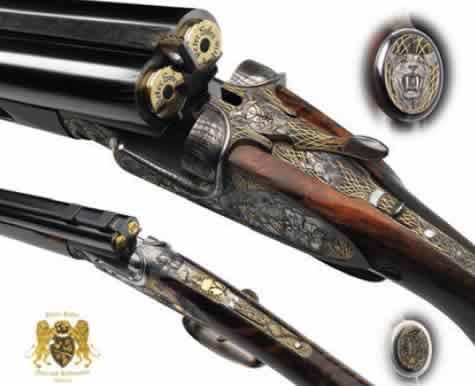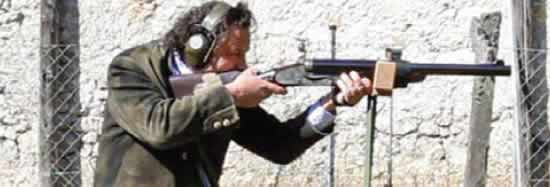
4 Bore Rifles – Magnum of Magnums

‘Think artillery’ when it comes to the 4-bore double rifles of Austrian gunmaker Peter Hofer.
STORY BY JIM DICKSON • PHOTOS BY PETER HOFER
The long, illustrious history of the 4-gauge rifle goes back to the days of the muzzleloaders first employed against the pachyderms of India and Africa. These guns reached perfection with the advent of the breech-loading cartridge guns.
The standard load was 14 drams of black powder behind a 1,882-grain slug, which would give an approximate velocity of 1,200 to 1,400 feet per second. The immense unbridled power of a shoulder gun firing the
maximum load for a ship’s swivel cannon generated 300 pounds of recoil energy in a 22-pound rifle. For the record, a ship’s swivel cannon larger than 4-bore size will normally tear itself out of the ship’s railing on firing.

To call the 4-bore rifle a cannon is no understatement. Its long rifled
barrel actually makes it more powerful than the ship’s swivel cannon.
The necessity of these monsters was driven by the inability of smallbore black powder rifles of the day to deal with the enormous beasts of India and Africa. In those days the big game had not yet learned the fear of the white hunter and attacks by big game while traversing thick cover could be expected.
Both 12-bore and 10-bore rifles were tried and found wanting on elephants and rhino, the latter of which might charge as a matter of policy upon being disturbed. There was also Africa’s Cape buffalo and Asia’s gaur, the largest of all the wild bovines, a monster that makes the Cape buffalo look like a runt in comparison. Only the 8-gauge and the 4-gauge proved up to the task of reliably stopping them under the worst conditions.
The 8-gauge guns with 200 pounds of recoil energy in an 18-pound rifle proved the most popular, as they were the most gun that many men could effectively use. For those who were man enough to handle them, the 4-gauge was the logical choice. It is worth noting that nothing has ever come close to the stopping power of the 8- and 4-gauge guns, regardless of the energy figures of high-velocity smokeless cartridges bandied about. When facing a charge from the largest and most dangerous game on Earth in thick cover at a range of just a few feet, you don’t want anything else. Trying to substitute smaller calibers with high velocity and paper energy figures for big heavy bullets on big game at close range has produced a long line of tombstones continuing down to the present day. Size does matter.
THE EXTREME WEIGHT and recoil of these behemoths led to the decline in their use when powerful smokeless powder rifles became available. Cartridge size is another factor that figured prominently in their demise, yet no one has ever put this in print. A box of 4-gauge shells weighs 25 pounds and will fill a Vietnam-era fanny pack. The shells themselves are just over an inch thick. Compare this to the svelt .577 3-inch Nitro Express, whose rounds fit nicely in shell loops on your shirt, and you can see that a full day’s shooting by a professional ivory hunter requires ammo bearers for the 4-gauge. The .577 Nitro Express has only half the recoil of the 8-gauge and a third the recoil of the 4-gauge, as well as a comparatively mild 100 foot-pounds of recoil energy. Don’t kid yourself. That still hurts.
But the demand for the ultimate stopping rifle never completely went away and very small numbers of 4-bore rifles continued to be built. I well remember handling a 4-bore hammerless H&H that I lacked sufficient funds to buy many years ago. In more recent years, the 4-bore was the subject of one of the most impressive feats of double rifle regulation ever done. The late David Perkins was one of the finest English Best Quality gunmakers of the 20th Century. Since most people only want to buy old established gunmaking names, he bought the Charles Lancaster name to make guns under.
Perkins was helping Mark Crudgington, another great gunmaker, build a 4-bore double rifle when he accomplished the great feat of calculating the amount of the wedge that would go between the barrels so that the gun was perfectly regulated the first time it was test fired. It was a feat made all the more difficult by the fact that double rifles have to be individually regulated, as the amount of spreading the barrels to prevent cross firing varies from gun to gun in the same caliber. The big gauge guns are a bit more forgiving, but still, this is the only time that I know of that this has been done successfully.

IN TODAY’S WORLD, velocity is king and magnums are all the rage. Austrian gunmaker Peter Hofer has risen to the challenge and built what can only be termed the 4-Bore Magnum, a gun firing a 1-inch-diameter 2,000-grain bullet at up to 2,624 feet per second.
The standard loads are a high load at 2,418 fps and a medium load at
1,903 fps. Hofer says the recoil of the medium load is 199.14 foot-pounds (that’s down to 8-bore recoil levels!), the high load is 317 foot-pounds, and the maximum load is 373.21 footpounds.
The maximum load has an energy of 30,671 foot-pounds. That’s five times higher than the impact energy of the .700 Nitro Express.
According to the Taylor Knock Out value formula, the 4-bore maximum load has a KO Factor of 750, the high load has a KO Factor of 690, and the medium load has a KO Factor of 543. This is emphatically and drastically superior to all the modern nitro calibers. The KO Factor of the .700 Nitro Express is a mere 196, while the .600 NE is 155.9, the .500 NE is 89.3, the .470 NE is 72.9, and the .416 Rigby is 57.1.
Accuracy of the 4-bore rifle is up to all standards for heavy-gauge rifles, as it groups within 9 centimeters (that’s 3.54 inches) at 40 yards with 1-inch-diameter bullets. You don’t use a heavy rifle on big game at long range. Remember the old elephant hunter’s advice to a newcomer to the trade: “Get as close as you can to the elephant and then get 10 yards closer.”
I would add the admonition to not overdo that, as I remember one hunter
who got too close and his elephant nearly fell on him when he shot it. You can overdo anything, it seems.
When firing a gun with over 300 foot-pounds of recoil energy, proper form is mandatory. You cannot brace against it and fight the recoil without getting injured. You have to lean into the gun and get a firm grip on it, as a gun of this size and recoil can fly out of your hands if held loosely and fired. If you have a long neck, you might be advised to brace it as well to prevent whiplash effect. Hold the gun firmly against the shoulder so that it does not work up speed before hitting you, but not so tight that the tissue is compressed before it has to be. Now relax the rest of your body and fire, letting the gun push you upright. People who fire big guns from a straight upright position or leaning backwards to better balance the heavy weight of the gun have no more room to be pushed back and end up knocked down. The trick is to roll with the punch like a boxer and allow yourself sufficient room to give with the blow and still not affect your balance.
THE 4-BORE MAGNUM weighs 30 pounds and is 49.9 inches long with a 24.4-inch barrel. This extra weight is absolutely necessary to handle the recoil of this monster. I just wish the black powder-era 4-bores had weighed this much. Smokeless powder produces less recoil than black powder and a special smokeless powder was developed to fill up the huge case. It had to burn slow, as a fast-burning powder would produce unbearable recoil at these velocities and could cause injury to the shooter. The huge slug had to be started slowly like a rocket lifting off for the gun to be safely fired at these velocities. The special high-volume powder with pores and a hollow body took years to develop. It is the only powder with sufficient volume and a slow enough burn rate to make this gun shootable at these high velocities. Personally I would be content with stopping at the ballistics of the original 4-bore load and would not want any more velocity than their medium load if I ever felt the need for more power. I definitely do not consider 30 pounds an excessive weight for any 4-bore and I am strong enough to easily handle a gun of this size. This is one gun I really wish I had the money to buy and go hunting with.
Getting the brass cases made to this size proved a daunting task and added to the headaches, time and cost of the project. Designing the ejectors was a hard task, as they would have to deal with cases that weigh 1 pound when fully loaded. Getting them strong enough to work without requiring excessive force to close the gun was a difficult problem. A lot of experimentation with the pivot points on the ejectors resulted in getting sufficient leverage that the extremely strong ejector springs are barely noticeable when closing the gun. Early 4-bore guns made with ejectors typically require you to hold the barrels further down toward the muzzle to get sufficient leverage to close them easily.
All told, it took 12 years to work out all the problems to develop this rifle, which then takes 10,000 working hours to make. That has raised the price considerably, as that money has to be recovered. Peter Hofer would have to build at least 10 weapons at $899,189 USD just to break even. Currently the price for this gun is $1 million USD. It’s not for everyone but it costs what it has to cost. Remember that this gun was
designed and made to push the limits of gunmaking and big game rifle
performance to a new level. The high cost of the years of development is the reason that no one else has done it. A project like this is done for the sake of doing it instead of mere monetary gain. When you want to make the best gun ever made in its category, the cost is high both to the maker and the customer.
The high cost of the years of development is the reason that no one else has done it. A project like this is done for the sake of doing it instead of mere monetary gain. When you want to make the best gun ever made in its category, the cost is high both to the maker and the customer.
Editor’s note: For more information, contact peterhofer@hoferwaffen.com
or visit hoferwaffen.com.


